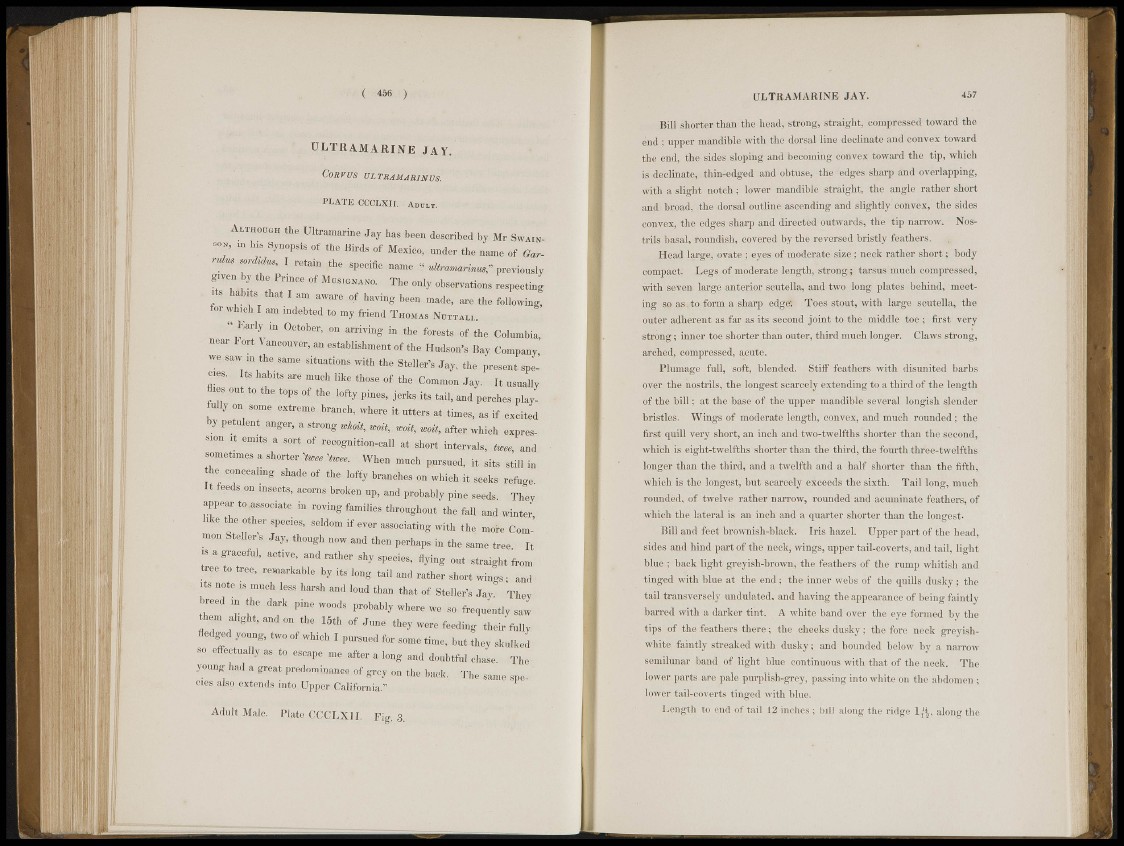
( 456. |
ULTRAMARINE JAY.
CORVVS irr.TUAM/lRlxus'.'
Pl.ATK «.'(SL.YIT Aoi-LT.
Jmmovcm tliu I:itramurh,e.;.J8y has been DESCRIBED In Mr SWMS-
» » , in h a Synopsis of the Birds of Mexico, und^the name of Garndm
sordid™, I r ^ ,the specific J M * ultramarine? previously
given b y t h e , P T i l l c e rf M S G N A I i a The ^ oWat .
o n s J
I • ** 1 W ¡ 8 1 havttg been made, ,are the following,
for which I am nuJafetf to my friend THOMAS .NUTTAL, .
" E a r l y in October, on arriving in .the forests of the Columbia,
near l o f 5 t Vaneouye r ,^n^ t e b l i s h m e n « t h e Hudson's Bay Company
we., saw in the same s tat ions with the Steller's Jfiy, the.present Spem
m Its habi t , are mud, like -thoss of the Common Jay. Ifemualv
; ; r ¡ H | I I • • • • • ,
7 ex t r f i m e ^e r e it utters at times, as if «cited
by pelulent. anger, a s t r o n g ^ « f t *oit, ,,oit, after which ezpres
s ^ z t » i t s a . « f t of recognition-call at short • H •
j a o f m e s a s h o r t c r ^ W When much pursued, it si* M in
the cijnjjeaJpsng shade of the l o f t branches on which jt seeks- refuge
I t feeds on in^eefs, acorns broken up, and probably pine seed,. They
a p p c a . t o ^ s o r i a « ^ r o w i n g f a * t h r o u g h o u t «fall, a^d winter
like the other species, seldom if ever associating with the mo*e Com-'
m p ^ t e j l e ^ Ja»y„ though now and then perhaps in the Sam-etre,*» It
IS a gragejul, active,, and rather shy species,, fljftgj out s t r a ight from
tree, re»arkabte^by > i « long tail aW rather',short wings • l i n d .
f
its note ,.us much harsh and loud than that of StelW's Jay. Thev
toed in the -lark pine woods probably where we- so frequently s i
hoin „1,,-ht, and, ,nth, . 15th,,. r „ n o they were feeding theirfelly
;
efled^.f oung, tyo Of which I pursued for -some time, but they skulked
so effectually as escape m after a long and fcrfrtftl „h^. Tte
yopng had a great predominance, of grey on the back. The same spe
Clonals;, extends into Upper California."
Adult Mafe, Plate COCLXII. Fig, 3.
ULTRAMARINE JAY. 457
Bill shorter than the head, strong, straight, compressed toward the
end ; upper mandibli'with the dorsal l ine deelinate and convex toward
the end, the sides sloping and becoming convex toward the tip, which
is deelinate; thin-edged and obtuse, the edges sharp find overlapping,
with a slight notch; lower mandible straight, the angle rather short
and broad, the dorsal outline ascending and slightly convex, the sides
convex, the edges sharp ami directed outwards, the tip narrow. Nostrils
basal, roundish, covered by thi> reversed bristly feathers.
Head large, ovate l^syjes of moderate size; neck rather short ; body
compact?- Legs of moderate length, strong; tarsus.muehi compressed,
whliK&ven large anterior soufolla, and two long plates behind, meeting
so as-to: form a sharp edge1. Toes, stout, with large seutella, the
outer adherent: as far as its second joint to the middle toe ; first very
strong; inner toe shorter than outer, third much longer. Claws strong,
arched, con,pressed, aeuto.
Plumage full, soft, blended. Stiff feathers with disunited barbs
over the nostrils, the longest scarcely extending to a third of the length
of the bill; at the ba>o of the upper mandible} several longish slender
bristles. Wings of moderate length, convex, and much rounded; the
first quill very short, an inch and two-twelfths shorter than the second,
which is eight-twelfths shorter than the third, the fourth three-twelfths
longer than the third, and a twelfth and a half shorter than the fifth,
which is the longest, but scarcely exceeds the sixth. Tail long, much
rounded, of twelve rather narrow, rounded and acuminate feathers, of
which the lateral is an inch and a quarter shorter than the longest.
Bill and feat brownish-black. Iris hazel. Upper par t of the head,
sides and hind part of the neck, wings, upper tail-coverts, and tail, light
blue ; back light ¡greyish-brown, the feathers: of the rump whitish and
tinged with blue at the end; the inner webs of the quills dusky ; the
tail transversely undulated, and having the appearance of being faintly
barred with a darker tint. A white band over the eye formed by the
tips of the feathers there; the cheeks dusky; the fore neck greyishwliite
faintly streaked with dusky; and bounded below by a narrow
semilunar band of light blue continuous with that of the neek. The
Ibwer parts are pale purplish-grey, passing into white on the abdomen ;
lower tail-e#y.erts tinged with blue.
Length to end of tail 12 incites ; bill along the ridge 1 along the